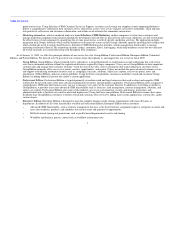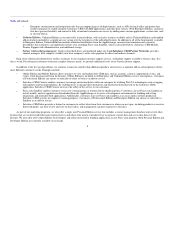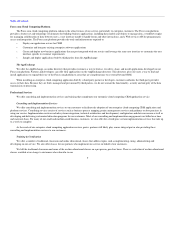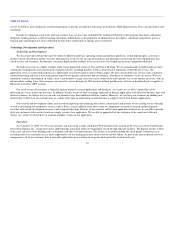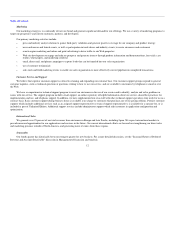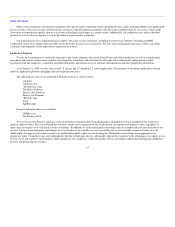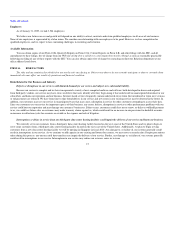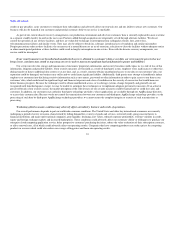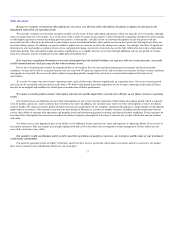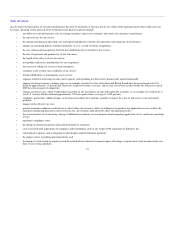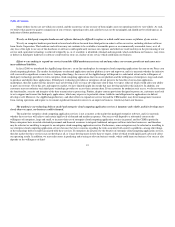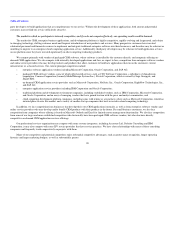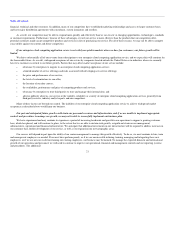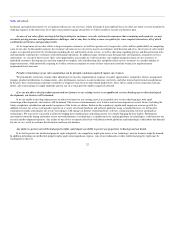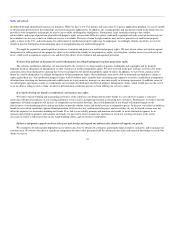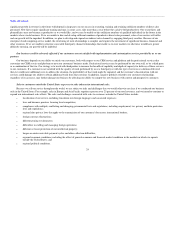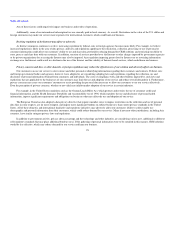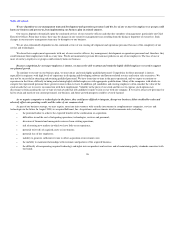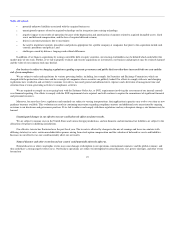Salesforce.com 2008 Annual Report Download - page 20
Download and view the complete annual report
Please find page 20 of the 2008 Salesforce.com annual report below. You can navigate through the pages in the report by either clicking on the pages listed below, or by using the keyword search tool below to find specific information within the annual report.
Table of Contents
Because we recognize revenue from subscriptions for our service over the term of the subscription, downturns or upturns in sales may not be
immediately reflected in our operating results.
We generally recognize revenue from customers ratably over the terms of their subscription agreements, which are typically 12 to 24 months, although
terms can range from one to 60 months. As a result, most of the revenue we report in each quarter is derived from the recognition of deferred revenue relating
to subscription agreements entered into during previous quarters. Consequently, a decline in new or renewed subscriptions in any one quarter will not
necessarily be fully reflected in the deferred revenue balance on our consolidated balance sheet and the revenue in that quarter but will negatively affect our
revenue in future quarters. In addition, we may be unable to adjust our cost structure to reflect the changes in revenues. Accordingly, the effect of significant
downturns in sales and market acceptance of our service, and potential changes in our rate of renewals may not be fully reflected in our results of operations
until future periods. Our subscription model also makes it difficult for us to rapidly increase our revenue through additional sales in any period, as revenue
from new customers must be recognized over the applicable subscription term.
If we experience significant fluctuations in our rate of anticipated growth and fail to balance our expenses with our revenue forecasts, our results
could be harmed and our stock price may decline without advance notice.
Due to our evolving business model, the unpredictability of new markets that we enter and deteriorating general economic and financial market
conditions, we may not be able to accurately forecast our rate of growth. We plan our expense levels and investment on estimates of future revenue and future
anticipated rate of growth. We may not be able to adjust our spending quickly enough if the rate of new or renewed subscriptions falls short of our
expectations.
As a result, we expect that our revenues, operating results and cash flows may fluctuate significantly on a quarterly basis. Our recent revenue growth
rates may not be sustainable and may decline in the future. We believe that period-to-period comparisons of our revenues, operating results and cash flows
may not be meaningful and should not be relied upon as an indication of future performance.
We cannot accurately predict customer subscription renewal rates and the impact these renewal rates will have on our future revenue or operating
results.
Our customers have no obligation to renew their subscriptions for our service after the expiration of their initial subscription period, which is typically
12 to 24 months, and in fact, some customers have elected not to renew. In addition, our customers may renew for fewer subscriptions or renew for shorter
contract lengths. We cannot accurately predict customer renewal rates, particularly for our enterprise customers who purchase a large number of subscriptions
under multi-year contracts. Our customers' renewal rates may decline or fluctuate as a result of a number of factors, including their dissatisfaction with our
service, their ability to continue their operations and spending levels and deteriorating general economic and financial market conditions. If our customers do
not renew their subscriptions for our service or reduce the number of paying subscriptions at the time of renewal, our revenue will decline and our business
will suffer.
Our future success also depends in part on our ability to sell additional features and services, more subscriptions or enhanced editions of our service to
our current customers. This may require increasingly sophisticated and costly sales efforts that are targeted at senior management. If these efforts are not
successful, our business may suffer.
Our quarterly results can fluctuate and if we fail to meet the expectations of analysts or investors, our stock price and the value of your investment
could decline substantially.
Our quarterly operating results are likely to fluctuate, and if we fail to meet or exceed the expectations of securities analysts or investors, the trading
price of our common stock could decline. Moreover, our stock price
17


